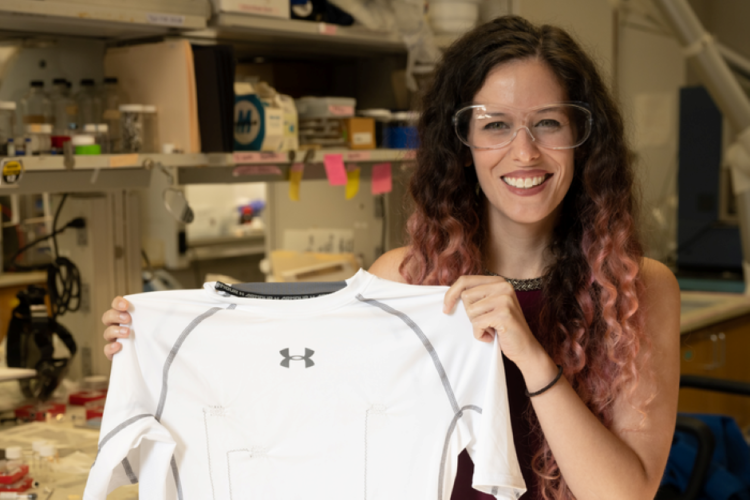
The fibres are as conductive as metal wires, but washable, comfortable and less likely to break when a body is in motion, claim researchers from the Brown School of Engineering lab of chemical and biomolecular engineer Matteo Pasquali. The team’s findings have been reported in Nano Letters.
The shirt is said to be better at gathering data than a standard chest-strap monitor taking live measurements during experiments. When matched with commercial medical electrode monitors, the carbon nanotube shirt gave slightly better EKGs.
“The shirt has to be snug against the chest,” said Rice graduate student Lauren Taylor, lead author of the study. “In future studies, we will focus on using denser patches of carbon nanotube threads so there’s more surface area to contact the skin.”
The researchers noted nanotube fibres are soft and flexible, and clothing that incorporates them is machine washable. The fibres can be machine-sewn into fabric just like standard thread. The zigzag stitching pattern allows the fabric to stretch without breaking them.
The fibres provided a steady electrical contact with the wearer’s skin and served also as electrodes to connect electronics like Bluetooth transmitters to relay data to a smartphone or connect to a Holter monitor that can be stowed in a user’s pocket, Taylor said in a statement.
Pasquali’s lab introduced carbon nanotube fibre in 2013. Since then the fibres, each containing tens of billions of nanotubes, have been studied for use as bridges to repair damaged hearts, as electrical interfaces with the brain, for use in cochlear implants, as flexible antennas and for automotive and aerospace applications. Their development is also part of the Rice-based Carbon Hub, a multi-university research initiative led by Rice and launched in 2019.
Carbon nanotubes show promise for 5G antennas
Video of the week: Rice chemists give helping hand to carbon nanotubes
The original nanotube filaments, at about 22 microns wide, were too thin for a sewing machine to handle. Taylor said a rope-maker was used to create a sewable thread - three bundles of seven filaments each - woven into a size roughly equivalent to regular thread.
“We worked with somebody who sells little machines designed to make ropes for model ships,” said Taylor. “He was able to make us a medium-scale device that does the same.”
She said the zigzag pattern can be adjusted to account for how much a shirt or other fabric is likely to stretch. Taylor said the team is working with Dr. Mehdi Razavi and his colleagues at the Texas Heart Institute to figure out how to maximise contact with the skin.
Fibres woven into fabric can also be used to embed antennas or LEDs, according to the researchers. Minor modifications to the fibres’ geometry and associated electronics could eventually allow clothing to monitor vital signs, force exertion or respiratory rate.
Taylor noted other potential uses could include human-machine interfaces for cars or soft robotics, or as antennas, health monitors and ballistic protection in military uniforms. “We demonstrated with a collaborator a few years ago that carbon nanotube fibres are better at dissipating energy on a per-weight basis than Kevlar, and that was without some of the gains that we’ve had since in tensile strength,” she said.
“We see that, after two decades of development in labs worldwide, this material works in more and more applications,” Pasquali said. “Because of the combination of conductivity, good contact with the skin, biocompatibility and softness, carbon nanotube threads are a natural component for wearables.”




Glasgow trial explores AR cues for autonomous road safety
They've ploughed into a few vulnerable road users in the past. Making that less likely will make it spectacularly easy to stop the traffic for...